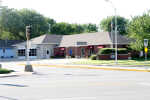You never know what a day at VCAD will bring

Nevada Daily Mail
In times of disaster, members of the local law enforcement and emergency services partner to bring aid to residents of Vernon County. But while police and fire departments often receive attention for their deeds, the local Emergency Medical Services can be overlooked.
"They're proud of their work," James McKenzie, director of the Vernon County Ambulance District, said of the team of about 16 full- and part-time paramedics and emergency medical technicians, but the Health Insurance Portability and Accountability Act (HIPAA) prevents the EMS from sharing information about much of their actions.
But while there is an amount of confidentiality involved in their job in order to protect their patients' privacy, the local EMS will be honored for their service to the community next week through the National EMS Week, May 17-23.
McKenzie has been director of VCAD for about 27 years, and part of the district for almost 29 years. During that time, McKenzie said he has seen several changes come to the local district and the EMS at a national level.
The new facility for the VCAD was constructed more than 15 years ago, with the district paying it off in a timely manner. The district continues to lease ambulances and other emergency vehicles, keeping five at a time.
Because of the increase in calls over the years, McKenzie said they might increase their fleet to having six vehicles available for calls.
When he first joined VCAD, McKenzie said they responded to only about one call a day, whether medical or request for a transfer. In 2014, they responded to about 2,600 calls for an average of more than seven calls a day.
"You just don't know what your shift will bring," McKenzie said, adding that on some days they will answer only three or four calls, while other days they will receive 12 or more calls for assistance.
McKenzie said he is unsure the reason why calls have increased, since the population has held steady. He also said the calls are not increasing among the senior adults but those between 30 and 50 years of age.
While answering calls only in Vernon County unless called to surrounding counties for mutual aid, VCAD also transfers patients to other hospitals as far away as Kansas City, Springfield or Joplin.
McKenzie said each 24-hour shift at VCAD begins with a meeting between shifts as they pass on their responsibilities to the next shift, giving an update on what is going on. Each morning, they also check all vehicles and equipment to make sure they are in working order.
As a means to save money, they maintain their own facilities. Paperwork also consumes a portion of time in each shift.
When not answering calls, McKenzie said those on shift use their time to practice or continue their training, becoming as proficient as possible in areas including swift water rescue, extrication and slope rescues.
Over the years, the training requirements have changed for EMTs and paramedics. VCAD has in-house EMT trainers but paramedics are required to take college courses, which often takes about a year, while training for an EMT lasts about six months.
"They get absorbed quickly into the services," McKenzie said of the graduates, saying at times there is a shortage of trained responders.
But the EMS has other trained volunteers they can call on when needed, including first responders and Community Emergency Response Team members, who volunteer their time.
When VCAD is called to an area of Vernon County that might take a lengthy period of time to reach, McKenzie said they will dispatch first responders from that area to respond, reaching the victims sooner. Those first responders have 50 hours of training in first aid and other training including search and rescue and extrication.
"We have a nice pool of first responders," McKenzie said, adding that the more trained people they have available in an emergency, the better. "They're a great asset."
CERT members receive 20 hours of training in basic first aid skills so they also can offer some assistance in case of an emergency.
"It helps you prepare yourself and then you can help your neighbors," McKenzie said of the CERT training.
McKenzie said the aid of those residents and others help greatly in emergencies and disasters, such as caused by severe weather. Even residents without that training have assisted the EMS at times when possible, such as when a tornado struck Nevada in 1995. McKenzie recalled residents who helped clear roadways as quickly as possible so emergency vehicles could get through.
"It's good to know we have strong support from our community," McKenzie said, saying he appreciates assistance as well as the gratitude shown by those they help.
But despite the help of residents and careful planning, McKenzie said it is impossible to be completely prepared for a major disaster, accident or storm, saying they learn from each scenario they face and know how to be a little better prepared in the future.
"You have to plan three steps ahead," McKenzie said, just in case one of those steps fail or is thwarted by the emergency.
Though at times the VCAD must deal with fake calls or even calls that endanger their own safety when they are forced to call for assistance from local law enforcement, McKenzie said they take pleasure in serving the community.
"We want to be the best part of your worst day," McKenzie said.
The EMS members also serve the community through education, visiting schools, hosting an annual haunted house and toy drive and even participating in Bushwhacker Days each year.
